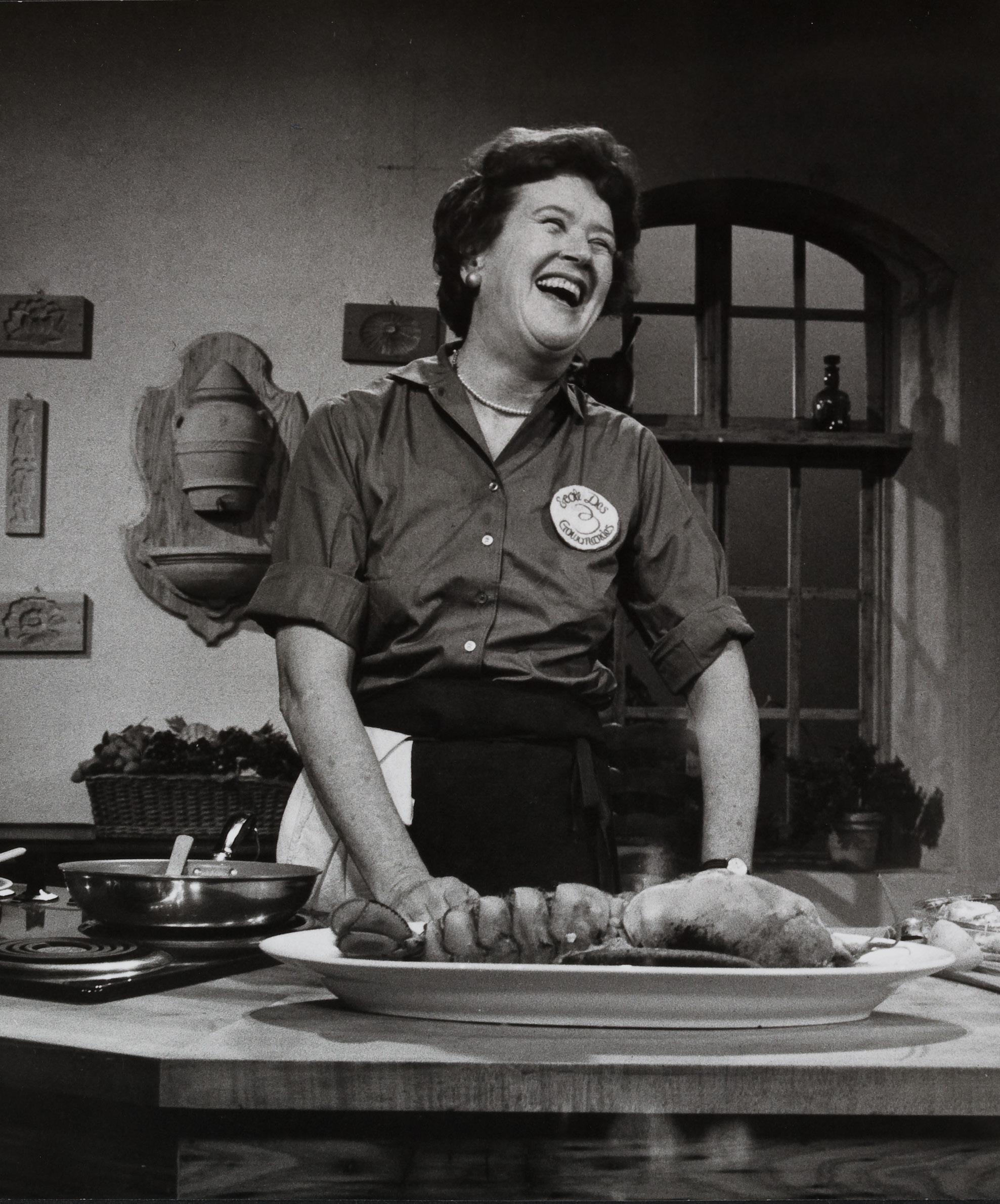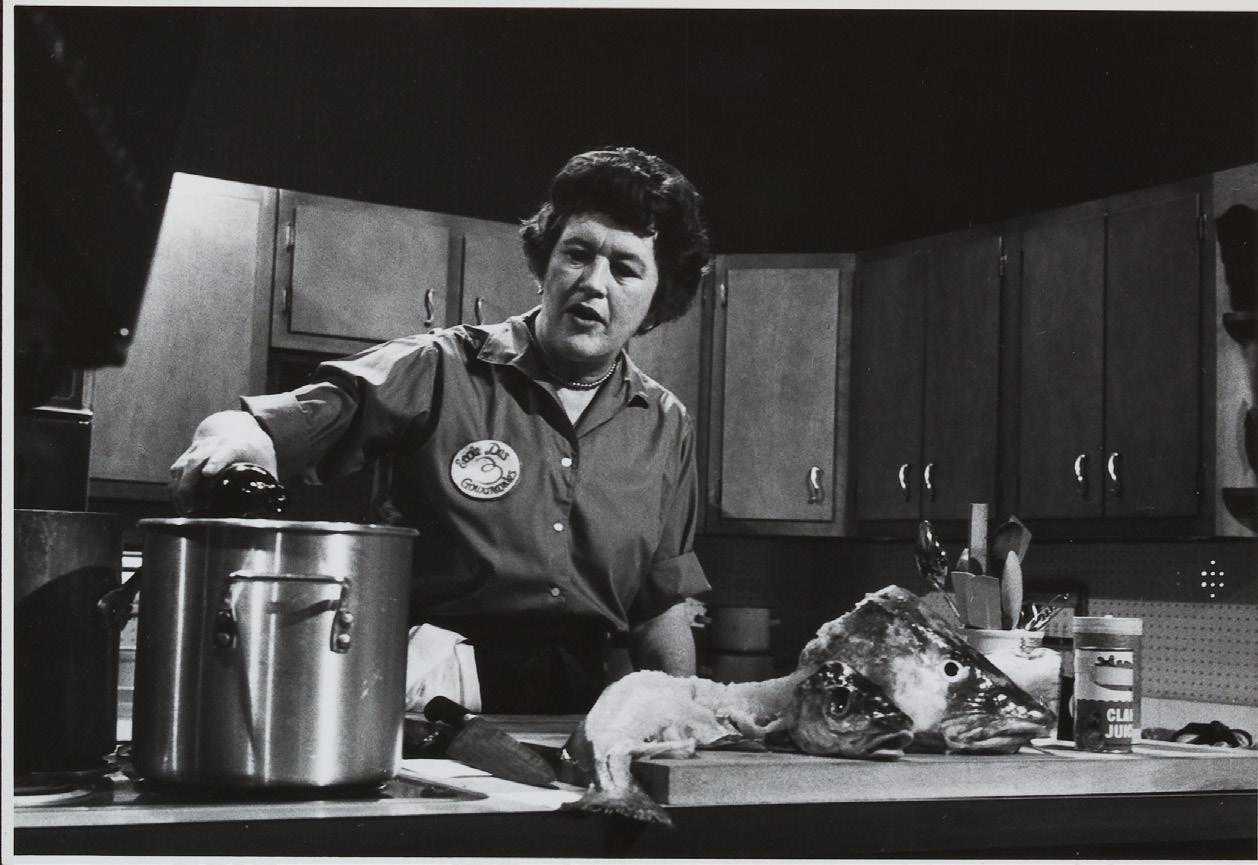
6 minute read
REMEMBERING JULIA
Julia Child’s signature joie de vivre shines through as she prepares lobster thermidor on an episode of The French Chef.

A vintage Yankee profile finds the queen of cooking pondering her next steps
The following is an abridged version of Richard Bacon’s article “Still Cooking with a Flair,” which originally appeared in the November 1979 issue of Yankee.
When we were first married,” Paul Child says, “Julia was always hungry, but she didn’t know enough about cooking to do anything about it.” With him as her incentive, she took a crash program in learning French, and then immersed herself in cooking lessons in Paris where they were living. Since then she has been doing her own culinary thing with steadily increasing confidence and command.
Some say she could coat the most abysmal meal with a layer of cheese, put it under the broiler for a few minutes, and present it as if it were ambrosia fit for the gods. Likely as not, it would be.
In popularizing the art of good eating, Julia Child has demonstrated to millions of stay-at-home cooks that a certain devil-may-care attitude and a dram of humor are nearly as essential as the raw materials all cooks deal with regularly. As with her traditional TV sign-off—a raised glass and a jaunty “Bon appétit”—Julia inspires confidence, even among those who have never felt an urge for culinary derring-do.
Julia Child has perfected the art of good teaching as well. She captures the attention with her energy and her somehow outrageous naturalness. Her husband calls her a clown, a ham even, and Julia doesn’t deny the charge. “When one is a teacher,” she says, smiling, “haven’t you found it so?”
In surely what must be an all-time film classic—as understated as the best of Charlie Chaplin—in the mid1960s millions watched her show, fascinated, while she absently fondled a suckling pig under one arm as if it were some strange house pet, cleaning its snout and ears with a towel, brushing its teeth. And all the time, straight on camera without the glimmer of a smile, she talked about the steps it takes to prepare a whole pig for the oven. Her performance convinced us it is a common thing to do for a special occasion, that the satisfaction to be had from eating roast suckling pig will be staggering if one is only willing to follow her simple lead.
Ruth Lockwood, her producer for the past 12 years, says, “Julia wants to show you how to do things properly. And if something goes wrong—which it does from time to time with all of us—she wants to make you feel confident enough to correct it. She wants to help other cooks eliminate the worry and fear of failure.”
One result of this demystifying process and of exposing the art of good cooking to a mass audience is that Julia Child has put fun and satisfaction back into the American kitchen.
“The kitchen should be the core of the home with a lot going on in it all the time,” she says. “The way to get people involved with each other is to involve them over food. Good eating and good company are marks of civilized living, don’t you agree? Without them we’d all be savages.”

For her work and pleasure Julia Child collects kitchen tools: a wall of heavy copper pots and pans, pegboards where each artifact hangs in its assigned place handy to an appropriate work area, drawers and cabinets organized with gadgets old and new. A mixer and a food processor stand at strategic points near electrical outlets behind the counter.
She is a professional cook who has the right tool for the right job, but she is also an unselfconscious performer who never seems to be at a loss when the unexpected happens. In fact, she is so well fortified with technical cooking skills that she seems to welcome the unusual, and always turns it to her own advantage, as if saying to her audience, “This is part of it. It happens to everyone. Now let’s see what we can do about it.”
Born in Pasadena, California, the eldest of three children, Julia came to cooking relatively late. She grew up
in a house similar to the one she and Paul live in now. Her mother was originally from western Massachusetts, so it seemed natural for Julia to come East for her education. After graduating from Smith College, she was drawn to Manhattan. She dreamed of writing for a national magazine but took a job instead with a large department store. She says now it trained her to be a stickler for observed detail, which was reinforced when WWII broke out and she worked for the OSS. It was there she met Paul.
They were married after the war was over, and Paul Child accepted a State Department assignment in Paris. After six months of lessons at the Cordon Bleu to learn

With The French Chef, Julia Child created one of the first cooking shows on U.S. television. The hit show, produced by Boston’s WGBH, ran for 10 years, and was followed by several others starring the charismatic Child.
TUNE IN FOR MORE
Hear some of Boston’s top female chefs pay homage to Julia Child on Weekends with Yankee season five.
the fundamentals of cooking French style, Julia continued private lessons with several French chefs.
Her original success was co-authoring the first volume of Mastering the Art of French Cooking with Simone Beck and Louisette Bertholle. The massive book took 10 years to prepare. When it was initially sent out to publishers, the manuscript was turned down. It was too long and did not follow a traditional pattern of presentation. Eventually, in 1961 Alfred A. Knopf was farsighted enough to take it on. It has been a cook’s bible ever since.
Then came TV. And more cookbooks. She collaborated again with Simone Beck on Volume Two of Mastering. Since then she has written The French Chef’s Cookbook, From Julia Child’s Kitchen, and Julia Child and Company.
Her latest series of 13 PBS programs, rehearsed and taped at Boston’s Channel 2, is Julia Child and More Company. But even as it was being filmed, another phase of Julia’s work began. Her latest book, of the same title, will be published by Knopf before the release of the television series and in time for the Christmas trade. Now she divides herself between her kitchen and her typewriter, between Cambridge and New York.
In some respects Julia Child’s 15 years of being workoriented have taken their toll. They have not diminished her standards or her enthusiasm, but they have affected her stamina. Now, after 250 televised cooking lessons since 1963, when The French Chef was first aired in the Boston area and then went on to become a national passion, the French Chef says she needs a rest.
“I’m 66 years old. I want more uninterrupted time to spend with Paul. We enjoy each other’s company. I need to further my own interests and my knowledge.”
She wants to take pastry lessons from a chef in France. She wants to have more time to experiment, to travel, to work up new ideas. One of her dreams is to inspire her producers to continue cooking lessons on TV but with a series of notable and different cooks. It would continue what she’s started.
“Maybe there will be more professionally trained chefs because of me,” she says. “More and more women are getting into the business. In the United States there seems to be more interest in professional cookery among the young than there is anywhere else in the world.
“Taste is such an important—and neglected—part of living, don’t you agree?”

